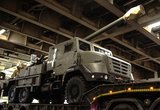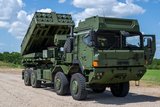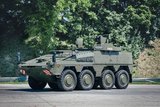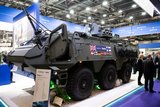First pilot Stryker DVH exchange vehicle completed
PEO Ground Combat Systems has announced that the US Army has completed the first vehicle in its Stryker Double V-Hull (DVH) exchange programme, which will see the flat-bottom Stryker replaced with hulls of the newer DVH design.
The new threat in Afghanistan led to an urgent requirement to change the design of the flat-bottom Stryker vehicles to a more survivable DVH model.
The programme is being carried out by the US Army's Project Manager, Stryker Brigade Combat Team (PM SBCT), in partnership with Anniston Army Depot (ANAD) and General Dynamics Land Systems (GDLS).
According to PEO Ground Combat Systems, the first vehicle to be completed is part of a pilot programme that will ‘validate if components from the traditional Stryker flat bottom hull (FBH) variants could be expeditiously refurbished and installed on a new, more survivable DVH, at less cost than producing a new vehicle’. The process includes reusing common parts from FBHs, refurbishing them, and re-using the parts in the new DVH structure. The DVH exchange vehicles are expected to have all of the same capabilities as new DVH production vehicles, and are built on the same production line as new DVH vehicles.
The teardown of the first two FBHs was completed this past summer, and the engineering effort produced ‘vital working teardown and rework directions which will be examined to find further efficiencies as well as a way to help determine exact costs’. ANAD will continue the disassembly of additional FBHs over the next several months. The reworked parts will be turned over to GDLS to be used in the new DVH structures being assembled at ANAD.
David Dopp, US Army project manager, SBCT, said: ‘The first vehicle is a significant milestone, but we still have more work to do. As the pilot programme progresses at Anniston, and more DVH exchange vehicles are built, processes established and actual costs are determined, the army will then be in a position to make informed decisions as to the benefits of further DVH exchange production should additional vehicle requirements emerge.’
Scott Davis, US Army's program executive officer for Ground Combat Systems, said: ‘The Stryker exchange programme is a prime example of how the army can work with industry to find mutually beneficial solutions to common challenges faced in this austere fiscal environment. Innovative partnerships between the army and industry remain crucial as we move forward, looking for ways to modernise the army's Stryker fleet to get the best vehicles in the hands of our soldiers, while trying to minimise costs to the taxpayer.’
The exchange programme is scheduled to be complete in early 2013. While further vehicles will have to be completed for the army to know exact savings, according to PEO Ground Combat Systems, it is currently estimated that DVH exchange vehicles will cost 40 percent less, when comparing them to a newly constructed DVH version.
More from Land Warfare
-
![Lockheed Martin to look further afield for GMARS rocket system opportunities]()
Lockheed Martin to look further afield for GMARS rocket system opportunities
The HX truck is already in use in many NATO and allied countries around the world as a logistics vehicle and carrier for high-value systems, including missile firing weapons, so its use for the Global Mobile Artillery Rocket System makes logistical sense.
-
![Beyond Survivability: How Active Protection Systems Are Empowering Commanders (Podcast)]()
Beyond Survivability: How Active Protection Systems Are Empowering Commanders (Podcast)
As threats diversify and intensify, APS are proving essential not just for vehicle protection but also for enhancing operational freedom, effectiveness and mission success in contested environments.
-
Medium knocked out of British Army LMP, with CAVS as heavyweight champion
As the British Army seeks to modernise and consolidate its diverse vehicle fleet, yet another change in direction is underway.






















